- 1NASA Ames Research Center, Moffet Field, CA, United States
- 2U.S. Naval Observatory, Washington, DC, United States
- 3NSF’s National Optical-Infrared Astronomy Research Laboratory, Tucson, AZ, United States
- 4NASA Exoplanet Science Institute, Caltech/IPAC, Pasadena, CA, United States
Starting in 2008, NASA has provided the exoplanet community an observational program aimed at obtaining the highest resolution imaging available as part of its mission to validate and characterize exoplanets, as well as their stellar environments, in search of life in the Universe. Our current program uses speckle interferometry in the optical (320–1,000 nm) with new instruments on the 3.5-m WIYN and both 8-m Gemini telescopes. Starting with Kepler and K2 follow-up, we now support TESS and other space- and ground-based exoplanet related discovery and characterization projects. The importance of high-resolution imaging for exoplanet research comes via identification of nearby stellar companions that can dilute the transit signal and confound derived exoplanet and stellar parameters. Our observations therefore provide crucial information allowing accurate planet and stellar properties to be determined. Our community program obtains high-resolution imagery, reduces the data, and provides all final data products, without any exclusive use period, to the community via the Exoplanet Follow-Up Observation Program (ExoFOP) website maintained by the NASA Exoplanet Science Institute. This paper describes the need for high-resolution imaging and gives details of the speckle imaging program, highlighting some of the major scientific discoveries made along the way.
1 Introduction
The study of exoplanets is one of the most important topics in astrophysics today. Starting over a decade ago, in support of the NASA Kepler mission, a program providing follow-up observations began. It became clear as Kepler was nearing launch, that the 4 arcsec pixels (Borucki et al., 2010) as well as the many possible confounding events which could imitate exoplanet transit events (e.g., Brown et al., 2011; Santerne et al., 2013) would require follow-up observations from ground-based telescopes in order to validate and characterize any discovered transit candidates. In addition, for transit observations it is crucial to know the stellar properties well, since the planet radius depends directly on the stellar radius. Also, given the relatively large pixels and multi-pixel photometric apertures, it is possible that more than one star is measured, and thus the transit measurement becomes even more uncertain or unreliable.
To support exoplanet discovery, spectroscopic follow-up observations consisted of medium- and high-resolution work using reconnaissance spectra at the start and then large telescope efforts once specific validation steps were passed (Furlan et al., 2018). Likewise, imaging observations were performed ranging from standard native seeing CCD imaging and lucky imaging to high-resolution observations (Furlan et al., 2017). These latter consisted of both Infrared Adaptive Optics (IR/AO) observations using Lick, Palomar, and Keck and optical speckle interferometric imaging using WIYN and Gemini telescopes.
As new exoplanet transit missions such as K2 (Howell et al., 2014), and the currently operating missions TESS (Ricker et al., 2015) and CHEOPS (Benz et al., 2020) come along, follow-up high-resolution (sub-arcsecond) imaging continues to be needed and in larger amounts than before. While Gaia can resolve companions down to near 1.0 arcsec and a bit closer using additional observations over time, e.g., EDR3; (Fabricius et al., 2016), it does not reach the spatial resolution of speckle imaging. Additionally, other exoplanet search techniques such as radial velocity (Kane et al., 2019) and ground-based small telescope transit surveys (Bakos et al., 2007) also benefit from speckle imaging of any candidate systems. Finally, the next wave of exoplanet space telescope missions will soon be upon us (Figure 1); missions covering larger and deeper sky areas such as PLATO (transits), and those hoping to obtain detailed exoplanet science such as the James Webb Space Telescope (JWST; transit spectroscopy, emission spectroscopy, direct imaging of exoplanets) and the Nancy Grace Roman Space Telescope (formally the Wide Field Infrared Survey Telescope [WFIRST]; direct imaging and microlensing planets), as well as complete spectroscopic characterization of exoplanet atmospheres with Ariel (Figure 2). Anywhere high-resolution imaging is needed, including for future missions such as LUVOIR, HabEX, or OST, our speckle program will be valuable. By that time, it is hoped that speckle imaging will be an integral part of the 30-m ground-based telescope system, providing angular resolutions near 5 mas.
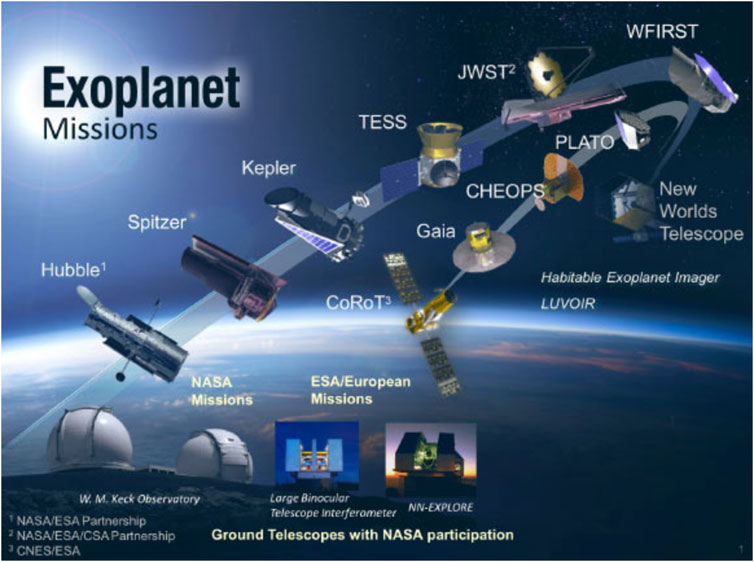
FIGURE 1. A schematic timeline of NASA and ESA exoplanet related space missions and the ground-based follow-up telescopes NASA directly participates in. Image Credit: NASA/JPL-Caltech.
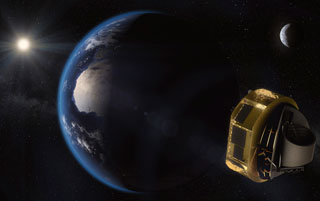
FIGURE 2. Artist concept of the Ariel space telescope. Image Credit: ESA/STFC RAL Space/UCL/Europlanet-Science Office.
For JWST, our program will provide high resolution imaging in support of targeted exoplanets and their host stars. Roman will make use of speckle imaging to support exoplanet research in two main ways: First, to vet and fully characterize direct exoplanet imaging targets in order to assess their multiplicity, and secondly, imaging of microlens sources to aid in the characterization of the source and lens stars.
This paper provides an overview of the NASA high resolution speckle imaging program. Exoplanet transit and radial velocity studies mainly focus on (A) F to M stars, however, our speckle imaging techniques have been used for research programs related to stars of all spectral and luminosity classes, extended objects, and Solar System bodies. These applications are not discussed further in this report. Section 2 discusses the need for high-resolution imaging, §3 presents the NASA mechanism to engage the exoplanet community, §4 and §5 give an overview of the instrumentation used, the community program, and data produced in this program, §6 lists some of the major scientific discoveries the speckle program has made in relation to exoplanet host star multiplicity, and finally we summarize in §7.
2 The Need for High-Resolution Imaging
Survey telescopes, such as Kepler and TESS, cover a wide field of view, but have large pixels on the sky. Kepler (and K2) had 4 arcsec/pixel values in their focal plane and TESS has 20 arcsec/pixel. These large pixels gather all the light from any stars present within the extracted photometric apertures. If a transit-like event is detected, it is not immediately obvious which star in the pixel (or actually in the pixels) used for light curve construction is the cause of the event. Thus, the status as a real exoplanet transit candidate remains in question until some form of validation is carried out.
Telescopes such as Hubble have great spatial resolution, but they come at the cost of a small field of view and large over-subscription rates for observational proposals. While space has the advantage of stable observing conditions and no atmospheric effects, high-resolution imaging from the ground must make use of clever means to attempt to “remove” the blurring effects of the atmosphere. IR/AO uses (laser) guide stars and deformable mirrors while speckle interferometry freezes the atmospheric distortions using many short exposures and reconstructs these into diffraction limited images using specialized software techniques.
Figure 3 illustrates these points for the case of KOI-1002 imaged from a typical ground-based telescope, Kepler, and TESS. The two bright stars in the top row of the figure are approximately 25 arcsec apart. The two stars are still separate in the Kepler image but near enough to place scattered light or even be both captured in any aperture used to measure the photometry. In the TESS image, it is difficult to even understand the scene. A good ground-based image, such as the top left image, can be used to help understand the star field imaged by TESS, but does not answer the question of which star had the transit-like event. The bottom row of Figure 3 shows optical speckle results obtained at Gemini and an IR adaptive optics image obtained at Keck for the star at the center of the top panel. Note the factor of
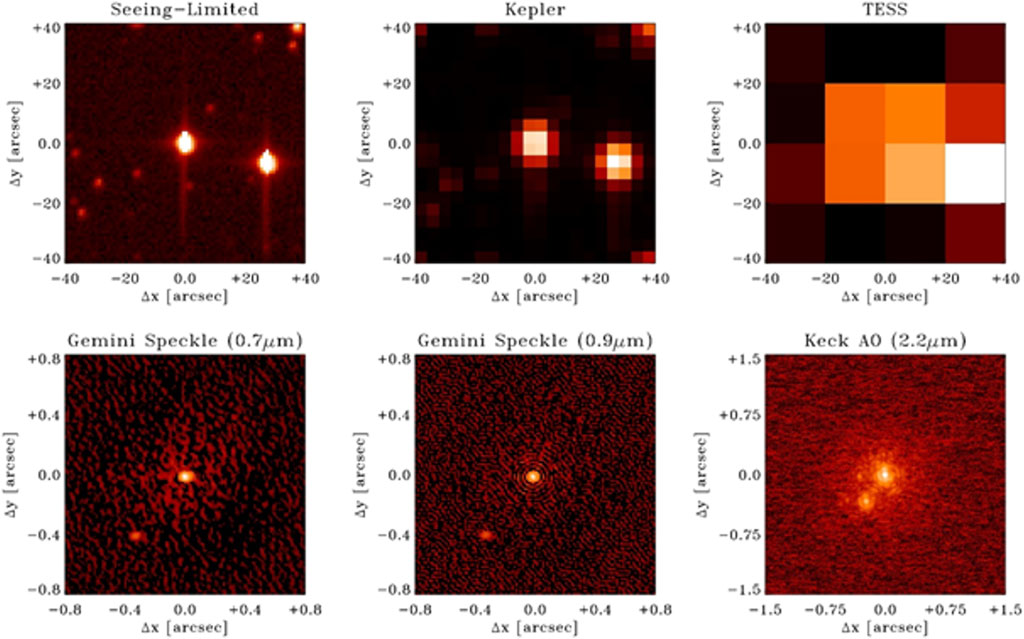
FIGURE 3. (Top row) Ground-based seeing-limited image of KOI-1002 (star at center) obtained from the Palomar Observatory Sky Survey (POSS). The image shows the local star field which contains two bright stars. The Kepler image is from the standard 30-minute postage stamp images downloaded from the spacecraft and the TESS “image” was produced (before TESS had observed the Kepler FOV) by convolving the Kepler image with the TESS 20 arcsec pixel size kernel. (Bottom row) Here the much smaller spatial dimension boxes are centered on the bright central star in the top row and it is revealed in the high-resolution images that the star is a binary system with a separation of about 0.5 arcsec. The Keck AO image shows the central 3 arcsec box. The speckle images took a total time of 5 min (3 min on source) and reached a contrast of 6.5 magnitudes while the IR/AO image required 15 min total time (
These types of follow-up high-resolution images are key to understanding the light within the scene of an exoplanet host star candidate. This is an important step in exoplanet validation and characterization. If the star is indeed multiple, and we know that about 40–50% of exoplanet host stars have one or more stellar companions (Horch et al., 2014; Matson et al., 2018), then knowledge of the brightness and type of any companion stars are crucial in order to properly assess the exoplanet and host star properties.
Ciardi et al. (2015); Wang et al. (2015); Furlan and Howell (2017); Deacon et al. (2016) and Ziegler et al. (2018), for example, have shown that the presence of third-light will mean that the planet radius determined from the transit depth alone is incorrect, the planet will always be larger than estimated from the transit depth, at times so large as to lose planet status. Furlan and Howell (2017) noted that such third-light properties will also decrease the mean density of the planet, possibly turning a terrestrial exoplanet into an ice giant as well as causing atmospheric scale height calculations to be flawed. These same two authors (Furlan and Howell, 2020) also showed how the lack of knowledge of a companion star could cause measured stellar properties, such as metal content and log g, to be incorrectly derived from an analysis of the star’s spectrum. Use of the knowledge of a companion (or not) allows a proper characterization of both the exoplanet and stellar properties. High resolution knowledge of the scene around host stars will remain an important diagnostic for future transit, direct imaging, microlens, and atmospheric spectroscopy exoplanet missions.
As an aside, Robo-AO is another high-resolution imaging technique used in the optical wavelength range. Ziegler et al. (2017) discuss their results using this method for exoplanet host stars. Unlike speckle imaging, Robo-AO uses the mechanical deformable mirror techniques of IR/AO and applies them to optical light. To date, this application has suffered from the use of small aperture telescopes (
3 The Speckle Imaging Program
Our speckle imaging program is set up under the auspices of NASA through the Exoplanet Exploration Office (ExEP) NN-EXPLORE program located at the Jet Propulsion Laboratory (JPL). The ExEP provides advocacy for the exoplanet community to NASA in terms of future mission science directions, needed technology, and exoplanet science critical to enable a full understanding of exoplanets, their environments, and the search for life. As an aid to establishing an open forum with the community, the ExEP maintains two “gap lists,” one for technology1 and one for science2. Each of these documents represent community vetted gaps, that is, areas which need additional understanding in the pursuit of exoplanet science. The ExEP science gap list contains twelve specific areas that the exoplanet community has agreed are in need of further, detailed understanding. Our speckle interferometry program directly addresses five of these science gaps and enables four additional ones.
Directly Addresses
• Science Gap 12 - Measurements of Accurate Transiting Planet Radii. Speckle imaging provides knowledge of companions, especially true bound companions and, if detected, the ability to correct the exoplanet radius and other properties for “third light”.
• Science Gap 07 - Properties of Known Exoplanet Host Stars. Speckle imaging provides knowledge of the multiplicity of exoplanet host stars providing accurate stellar parameters and directly assessing the topics of exoplanet formation, migration, dynamics, and evolution.
• Science Gap 10 - Precursor Observations of Direct Imaging Targets. Speckle imaging provides exploratory observations of potential targets for future direct imaging and atmospheric observation missions, assessing their multiplicity and thus their potential as high-value targets.
• Science Gap 04 - Planetary System Architectures: Occurrence Rates for Exoplanets of all sizes. Speckle imaging allows the correct exoplanet and stellar properties to be determined. This in turn is used to derive robust occurrence rates for exoplanets orbiting stars in multiple star systems.
• Science Gap 05 - Occurrence Rates and Uncertainties for Temperate Rocky Planets (eta-Earth). Speckle imaging addresses exoplanet occurrence rates as described above and allows habitable zone locations in binary host star systems to be determined yielding eta-Earth rates for temperate planets.
Enables
• Science Gap 01—Spectral characterization of atmospheres of small exoplanets
• Science Gap 02—Modeling exoplanet atmospheres
• Science Gap 03—Spectral signature retrieval
• Science Gap 06—Yield estimation for exoplanet direct imaging missions.
4 The Speckle Instruments
Just before the Kepler mission was launched, we began our speckle imaging work to support the NASA community. At that time, we used the Differential Speckle Survey Instrument (DSSI; Horch et al., 2009) on the 3.5-m WIYN telescope located on Kitt Peak in southern Arizona, United States. This instrument was a workhorse during the Kepler mission, providing high-resolution images of
Each of the new instruments provide simultaneous observations in two optical bands, determined by filters placed in each of two beams, split at 700 nm. Figure 4 presents a schematic of the Gemini instruments with the major parts labeled and Figure 5 shows one of the instruments being constructed in our optics lab at NASA Ames (left) and the completed instrument mounted on the Gemini telescope (middle and right). Table 1 presents the general parameters of these new instruments with ’Alopeke and Zorro being identical therefore having identical parameters. The instruments have two field of view options user selectable in real-time; a narrow speckle imaging field and a wider more traditional imaging field of view. The angular resolution of these instruments provide inner working angle spatial resolutions for nearby exoplanet host stars (e.g., TESS) of
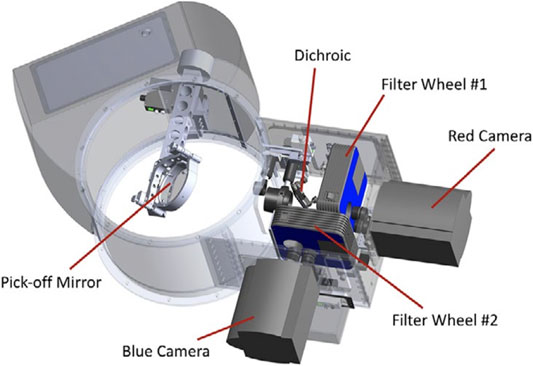
FIGURE 4. Schematic CAD drawing of ’Alopeke or Zorro (they are identical), the speckle instruments residing at the twin Gemini 8-m telescopes. The compact design is illustrated along with the primary parts labeled. ’Alopeke and Zorro both mean fox in the language of the local people.
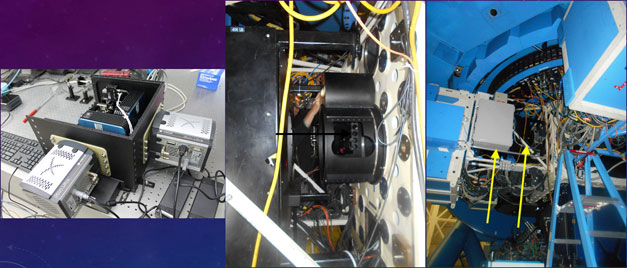
FIGURE 5. (Left) One of the two identical speckle imagers under construction at the NASA Ames Research Center. The two grey boxes extending out of the black box are the two Andor EMCCD cameras. (Middle) A close-up view of the instrument mounted on Gemini at the GCAL port and (Right) a view of the instrument (black box) with the associated power supply, electronics, and computer unit (white box). See yellow arrows.
These instruments are fully integrated into the telescope control systems where they reside and the Gemini instruments are permanently mounted for use at any time during the year. ‘Alopeke and Zorro are able to be operated remotely from the Gemini control room or anywhere internet is available via a secure connection to the observatory.
5 The Community Observing Program
The NASA speckle imaging program is openly available to the world-wide exoplanet community. While we have built and deployed the speckle instruments, our observing protocol is a community-based program with targets and observing priorities set by the missions and the community.
Below, we discuss the observational program, the target selection methodology, the data reduction processes, and the archives which house the raw and reduced data products.
5.1 Observations
Proposals to use the speckle instruments, including proposals submitted by our team, are peer reviewed for each telescope by the relevant telescope allocation committee (TAC). Once the approved programs are known for a semester, we work with each observatory to set up block scheduled observation runs, once or twice each semester on each telescope. Each run consists of 6–10 nights depending on time demand.
All speckle targets are placed in a queue to be observed by our team during the observing block. Most targets are observed in the usual manner (Howell et al., 2011) that is, thousands of 40 to 60 msec images are simultaneously collected in two narrow band filters, one each in the blue and red regions of the optical bandpass. Here blue and red are defined by the dichroic in our instruments, splitting the optical light at 700 nm (See Table 1). Some observations may come with special requirements such as the use of specific filters, extended integration times, or specific time constraints.
5.2 Target Selection
Targets to observe are selected in three main ways. First, each space mission or ground-based exoplanet program has a team of scientists and staff designated to produce a priority list of targets to be observed. These targets, usually called “objects of interest” (e.g., Kepler objects of interest, KOIs or TESS objects of interest, TOIs) are listed in priority order and provided to our observing team ahead of each observation run. For example, the TESS Follow-up Observing Program Working Group as well as the TESS sub-group for high-resolution imaging (SG3) play roles in target ranking and selection. The priority order reflects target brightness, number, location or type of exoplanet candidates, or stellar properties. The list contains 100–200 targets at a time and gets updated throughout each observing season.
The second main way is direct communication with our group. If an exoplanet host star is in need of high-resolution imaging, regardless of what space mission or ground-based telescope discovered it or who is currently studying the target, we will add it into our priority list and observe the target for the PI. This method usually involves 1 to a few targets of immediate interest to someone in the exoplanet community.
Finally, PIs can propose for telescope time themselves as each of our instruments at their associated telescopes have “open sky” policies, that is, proposals are accepted from anyone.
5.3 Data Reduction
Speckle interferometry produces diffraction-limited images over a small field of view (
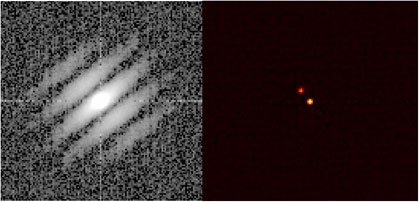
FIGURE 6. Power spectrum of TOI-1356, an exoplanet hosting star, produced by our reduction pipeline using 2000 speckle images and obtained at the WIYN telescope. Note the interference fringes whose spacing, intensity, and orientation allow a reconstructed image (right) to be produced. From this image and the Fourier analysis, we can determine the separation, position angle, and magnitude difference of the two stars. In this case, the host star is a member of a close binary having a separation near 0.16 arcsec. The reconstructed image is 2 arcsec on a side.
Speckle imaging has been used since the early 1970’s but has been greatly upgraded since then, now using digital detectors, large telescopes, and advanced software techniques. For example, EMCCDs provide for electron multiplication in the output gain register, increasing the input signal by up to 1,000 times. Stars as faint as 19th magnitude can now be observed using our instruments at Gemini coupled with their EMCCD detectors.
Our standard data reduction pipeline and the data products available are described in Howell et al. (2011) with some additional reduced data products now provided (e.g., Figure 7). The following reduced data products are delivered to each PI: sensitivity curves, reconstructed images, and any binary fit parameters if a companion is detected.
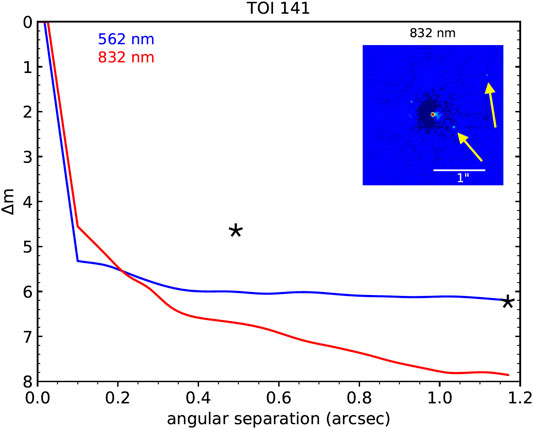
FIGURE 7. One of our standard pipeline reduced data products. The plot shows our 5σ contrast curves in both filters as a function of the angular separation out to 1.2 arcsec, the end of speckle coherence. In addition, the inset shows the reconstructed 832 nm image with a 1 arcsec scale bar. This star, TOI 141, was found to have two close companions, one at 0.5 arcsec (PA = 240 degrees, Delta magnitude = 4.6) and one at 1.3 arcsec (PA = 307 degrees, Delta magnitude = 6.2). The yellow arrows mark the companions in the reconstructed image and the black stars mark the locations of the stars on the main plot, the 1.3 arcsec companion placed at 1.2″ to fit within the plot.
5.4 Data Archives
Our raw data and reduced data products are archived at both the Gemini data archive6 and the NASA Exoplanet Archive, Exoplanet Follow-up Program (ExoFOP) archive7. They are accessible to the public once the proprietary period has ended. All of our community observations, that is those observed within the NASA proposed program time, are available to the public with no proprietary period. Other PIs observing exoplanet targets can specify a proprietary period of up to 12 months, however, most PIs choose no proprietary period as well.
All observed targets are listed on the Exoplanet Follow-Up Observation Program website8 within days of an observing run; in this way the community is informed about which exoplanet host stars have been imaged with our speckle instruments. Final data products from the reductions are also posted on ExoFOP; tags link them to the corresponding entries in the imaging observations tables. For targets observed as part of our community program, the reduced data products are posted on ExoFOP soon after an observing run ends and the reduction has been completed, typically within a few weeks. To date, we have observed over 1,000 exoplanet host stars from Kepler and K2 and more than 500 TESS mission TOIs, so far, for the community. These observations have been used to validate and characterize exoplanets in over 65 published papers in the past 1.5 years.
6 Discoveries in Stellar Multiplicity
In addition to validating and characterizing numerous exoplanet discoveries as contributions to the exoplanet community research, we have used the large samples of exoplanet host stars observed at high resolution to enable a number of overarching findings.
(1) Percentage of binary exoplanet host stars: For both the Kepler and K2 exoplanet host stars, and it seems true also for TESS, we have shown that for those stars hosting at least one exoplanet, 40–50% of them reside in binary or multiple star systems; See Horch et al. (2014); Matson et al. (2018) and the upcoming papers by Howell et al. (2021) and Lester et al. (2021)9.
(2) Binary host star properties: Recent work (Howell et al., 2021) has shown that the mass ratio of exoplanet host star binaries follows that of field binaries, that is an excess of nearly equal mass systems. The orbital period distribution however does not. These authors find that exoplanet hosting binary stars show generally larger mean separations having a peak in their orbital separation near 100 au, not 40 au as for the field sample (Raghavan et al., 2010). Furlan and Howell (2017) and Furlan and Howell (2020) have shown that it is critical to fully understand the “scene” of light near an exoplanet host star. If a close companion is present, both the exoplanet and the stellar properties determined may be in error.
(3) Bound vs. line of sight companions: Using statistical modeling, Horch et al. (2014) and Matson et al. (2018) have shown that most stellar companions that reside within 0.4 arcsec (at Gemini) and 0.8 arcsec (at WIYN) of the primary star are true bound companions (at
(4) Which star in a binary hosts the exoplanet: Transit discoveries in binary host stars often leave open the question of which of the stars the exoplanet(s) actually orbit. If the planet orbits the primary, the transit depth may require only a modest correction due to a fainter secondary star. However, if the transit is due to something orbiting the secondary star or the two stars are nearly equal in brightness, it can be very unclear what the measured transit depth is really telling us. One way to solve this dilemma was employed by Howell et al. (2019) for the binary A star exoplanet host Kepler-13. Using simultaneous time-series speckle observations of both stars in the pair, it was shown that the transit occurs on Kepler-13A.
7 Summary
We have summarized our continuing decade long NASA high resolution imaging work for exoplanet research. Using speckle interferometry, we carry out a community led observational program that supports space- and ground-based exoplanet efforts. Observations are obtained at the WIYN 3.5-m telescope in Arizona, and at both the Gemini-North and Gemini-South 8-m telescopes located in Chile and Hawaii. We have designed and built new instruments for these telescopes that are available to the community through peer review proposals under the NN-EXPLORE/NOIRLabs open-sky policies. All our observations and their fully reduced data products are made available via public data archives.
Sub-arcsec imaging, especially inside of 0.4 arcsec, is critical for our detailed understanding of exoplanets, their host stars, and the search for other life in the Universe. Exoplanet radii and mean densities, plus the stellar properties of their hosts, can be incorrectly determined without proper knowledge of the close-in light scene.
Our imaging program has supported many exoplanet validation and characterization studies for space missions and ground-based surveys, and radial velocity studies as well as made scientific findings itself along the way.
We plan to continue our community service program throughout the TESS extended mission and into the JWST and Roman missions and beyond.
Data Availability Statement
The datasets presented in this study can be found in the online NASA Exoplanet archive: https://exoplanetarchive.ipac.caltech.edu.
Author Contributions
SH—wrote the majority of the manuscript, leads the program NS, EF, RM—made substantial contributions to the manuscript ME, DC, KL, CG—Part of observation/instrument team.
Acknowledgments
We thank Elliott Horch and William Sherry for their previous team work. Additionally, we thank the generous support and collaboration of the staff at the WIYN and Gemini Telescopes, they are indeed part of the Team. We appreciate the reviews by the referees which led to a better paper. Finally, we’d like to thank NASA headquarters and the Exoplanet Program Office at JPL, in particular, Doug Hudgins, Gary Blackwood, and John Callas, for their substantial support of the speckle imaging program over these many years. Facilities: WIYN: 3.5 m (NESSI), Gemini-North:8-m (’Alopeke), Gemini-South:8-m (Zorro).
Conflict of Interest
The authors declare that the discussion and research was conducted in the absence of any commercial or financial relationships that could be construed as a potential conflict of interest.
Footnotes
1https://exoplanets.nasa.gov/exep/technology/gap-lists/
2https://exoplanets.nasa.gov/internal_resources/1547/
3https://www.wiyn.org/Instruments/wiynnessi.html
4https://www.gemini.edu/instrumentation/current-instruments/alopeke-zorro
5Scott, N. et al., 2021 is in preparation
6https://archive.gemini.edu/searchform
7https://exoplanetarchive.ipac.caltech.edu
8https://exofop.ipac.caltech.edu/tess/
9Lester k, et al. (2021) is in preparation
References
Bakos, G. Á., Kovács, G., Torres, G., Fischer, D. A., Latham, D. W., Noyes, R. W., et al. (2007). HD 147506b: a supermassive planet in an eccentric orbit transiting a bright star. Acta Pathol. Jpn. 670 (1), 826–832. doi:10.1086/521866
Benz, W., Broeg, C., Fortier, A., Rando, N., Beck, T., Beck, M., et al. (2020). The CHEOPS mission. Exp. Astro. 51, 109–151. doi:10.1007/s10686-020-09679-4
Borucki, W. J., Koch, D., Basri, G., Batalha, N., Brown, T., Caldwell, D., et al. (2010). Kepler planet-detection mission: introduction and First results. Science 327 (5968), 977. doi:10.1126/science.1185402
Brown, T. M., Latham, D. W., Everett, M. E., and Esquerdo, G. A. (2011). Keplerinput catalog: photometric calibration and stellar classification. Astron. J. 142 (4), 112. doi:10.1088/0004-6256/142/4/112
Ciardi, D. R., Beichman, C. A., Horch, E. P., and Howell, S. B. (2015). Understanding the effects of stellar multiplicity on the derived planet radii from transit surveys: implications for Kepler, K2, and Tess. Acta Pathol. Jpn. 805 (1), 16. doi:10.1088/0004-637x/805/1/16
Colton, N. M., Horch, E. P., Everett, M. E., Howell, S. B., Davidson, J. W. J., Baptista, B. J., et al. (2020). Identifying bound stellar companions to Kepler exoplanet host stars using speckle imaging. arXiv e-prints, arXiv:2011.03903.
Deacon, N. R., Kraus, A. L., Mann, A. W., Magnier, E. A., Chambers, K. C., Wainscoat, R. J., et al. (2016). A Pan-STARRS 1 study of the relationship between wide binarity and planet occurrence in the Kepler field. Mon. Not. Roy. Astron. Soc. 455 (4), 4212–4230. doi:10.1093/mnras/stv2132
Everett, M. E., Barclay, T., Ciardi, D. R., Horch, E. P., Howell, S. B., Crepp, J. R., et al. (2015). High-resolution multi-band imaging for validation and characterization of small Kepler planets. AJ 149 (2), 55. doi:10.1088/0004-6256/149/2/55
Fabricius, C., Bastian, U., Portell, J., Castañeda, J., Davidson, M., Hambly, N. C., et al. (2016). Gaia Data Release 1. Pre-processing and source list creation. arXiv 595. doi:10.1051/0004-6361/201628643
Furlan, E., Ciardi, D. R., Cochran, W. D., Everett, M. E., Latham, D. W., Marcy, G. W., et al. (2018). The Kepler follow-up observation program. II. Stellar parameters from medium- and high-resolution spectroscopy. Acta Pathol. Jpn. 861 (2), 149. doi:10.3847/1538-4357/aaca34
Furlan, E., Ciardi, D. R., Everett, M. E., Saylors, M., Teske, J. K., Horch, E. P., et al. (2017). The Kepler follow-up observation program. I. A catalog of companions toKeplerstars from high-resolution imaging. AJ 153 (2), 71. doi:10.3847/1538-3881/153/2/71
Furlan, E., and Howell, S. B. (2017). The densities of planets in multiple stellar systems. AJ 154 (2), 66. doi:10.3847/1538-3881/aa7b70
Furlan, E., and Howell, S. B. (2020). Unresolved binary exoplanet host stars fit as single stars: effects on the stellar parameters. Acta Pathol. Jpn. 898 (1), 47. doi:10.3847/1538-4357/ab9c9c
Hirsch, L. A., Ciardi, D. R., Howard, A. W., Everett, M. E., Furlan, E., Saylors, M., et al. (2017). Assessing the effect of stellar companions from high-resolution imaging of Kepler objects of interest. AJ 153 (3), 117. doi:10.3847/1538-3881/153/3/117
Horch, E. P., Howell, S. B., Everett, M. E., and Ciardi, D. R. (2014). Most sub-arcsecond companions of Kepler exoplanet candidate host stars are gravitationally bound. Acta Pathol. Jpn. 795 (1), 60. doi:10.1088/0004-637x/795/1/60
Horch, E. P., Veillette, D. R., Baena Gallé, R., Shah, S. C., O'Rielly, G. V., and van Altena, W. F. (2009). Observations of binary stars with the differential speckle survey instrument. I. Instrument description and first results. Astron. J. 137 (6), 5057–5067. doi:10.1088/0004-6256/137/6/5057
Howell, S. B., Everett, M. E., Sherry, W., Horch, E., and Ciardi, D. R. (2011). Speckle camera observations for the NASA Kepler mission follow-up program. Astron. J. 142 (1), 19. doi:10.1088/0004-6256/142/1/19
Howell, S. B., Matson, R. A., Ciardi, D. R., Everett, M. E., Livingston, J. H., Scott, N. J., et al. (2021). Speckle observations of TESS exoplanet host stars: understanding the binary exoplanet host star orbital period distribution. Astron. J. [in press].
Howell, S. B., Scott, N. J., Matson, R. A., Horch, E. P., and Stephens, A. (2019). High-resolution imaging transit photometry of Kepler-13AB. AJ 158 (3), 113. doi:10.3847/1538-3881/ab2f7b
Howell, S. B., Sobeck, C., Haas, M., Still, M., Barclay, T., Mullally, F., et al. (2014). The K2 mission: characterization and early results. Publ. Astron. Soc. Pac. 126 (938), 398. doi:10.1086/676406
Kane, S. R., Dalba, P. A., Li, Z., Horch, E. P., Hirsch, L. A., Horner, J., et al. (2019). Detection of planetary and stellar companions to neighboring stars via a combination of radial velocity and direct imaging techniques. AJ 157 (6), 252. doi:10.3847/1538-3881/ab1ddf
Matson, R. A., Howell, S. B., and Ciardi, D. R. (2019). Detecting unresolved binaries in TESS data with speckle imaging. AJ 157 (5), 211. doi:10.3847/1538-3881/ab1755
Matson, R. A., Howell, S. B., Horch, E. P., and Everett, M. E. (2018). Stellar companions of exoplanet host stars in K2. AJ 156 (1), 31. doi:10.3847/1538-3881/aac778
Raghavan, D., McAlister, H. A., Henry, T. J., Latham, D. W., Marcy, G. W., Mason, B. D., et al. (2010). A survey of stellar families: multiplicity of solar-type stars. APJs 190 (1), 1–42. doi:10.1088/0067-0049/190/1/1
Ricker, G. R., Winn, J. N., Vanderspek, R., Latham, D. W., Bakos, G. Á., Bean, J. L., et al. (2015). Transiting exoplanet survey satellite (TESS). J. Astronomical Telesc. Instrum. Syst. 1, 014003. doi:10.1117/1.JATIS.1.1.014003
Santerne, A., Fressin, F., Díaz, R. F., Figueira, P., Almenara, J.-M., and Santos, N. C. (2013). The contribution of secondary eclipses as astrophysical false positives to exoplanet transit surveys. AAP 557, A139. doi:10.1051/0004-6361/201321475
Scott, N. J., Howell, S. B., Horch, E. P., and Everett, M. E. (2018). The NN-explore exoplanet stellar speckle imager: instrument description and preliminary results. PASP 130 (987), 054502. doi:10.1088/1538-3873/aab484
Wang, J., Fischer, D. A., Xie, J.-W., and Ciardi, D. R. (2015). Influence of stellar multiplicity on planet formation. Iv. Adaptive optics imaging of Kepler stars with multiple transiting planet candidates. Acta Pathol. Jpn. 813 (2), 130. doi:10.1088/0004-637x/813/2/130
Ziegler, C., Law, N. M., Baranec, C., Howard, W., Morton, T., Riddle, R., et al. (2018). Robo-AO Kepler Survey. V. The Effect of Physically Associated Stellar Companions on Planetary Systems. AJ 156 (2), 83. doi:10.3847/1538-3881/aace59
Keywords: exoplanets, high-resolution imaging, speckle interferometry, binary stars, exoplanet demographics
Citation: Howell SB, Scott NJ, Matson RA, Everett ME, Furlan E, Gnilka CL, Ciardi DR and Lester KV (2021) The NASA High-Resolution Speckle Interferometric Imaging Program: Validation and Characterization of Exoplanets and Their Stellar Hosts. Front. Astron. Space Sci. 8:635864. doi: 10.3389/fspas.2021.635864
Received: 30 November 2020; Accepted: 20 January 2021;
Published: 05 March 2021.
Edited by:
Susan Elizabeth Mullally, Space Telescope Science Institute (NASA), United StatesReviewed by:
Ji Wang, The Ohio State University, United StatesRamses Mario Ramirez, Tokyo Institute of Technology, Japan
Copyright © 2021 Howell, Scott, Matson, Everett, Furlan, Gnilka, Ciardi and Lester. This is an open-access article distributed under the terms of the Creative Commons Attribution License (CC BY). The use, distribution or reproduction in other forums is permitted, provided the original author(s) and the copyright owner(s) are credited and that the original publication in this journal is cited, in accordance with accepted academic practice. No use, distribution or reproduction is permitted which does not comply with these terms.
*Correspondence: Steve B. Howell, c3RldmUuYi5ob3dlbGxAbmFzYS5nb3Y=
 Steve B. Howell
Steve B. Howell Nicholas J. Scott
Nicholas J. Scott Rachel A. Matson
Rachel A. Matson Mark E. Everett3
Mark E. Everett3